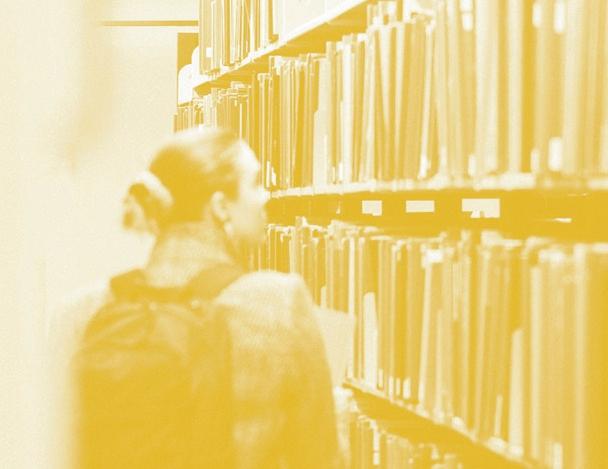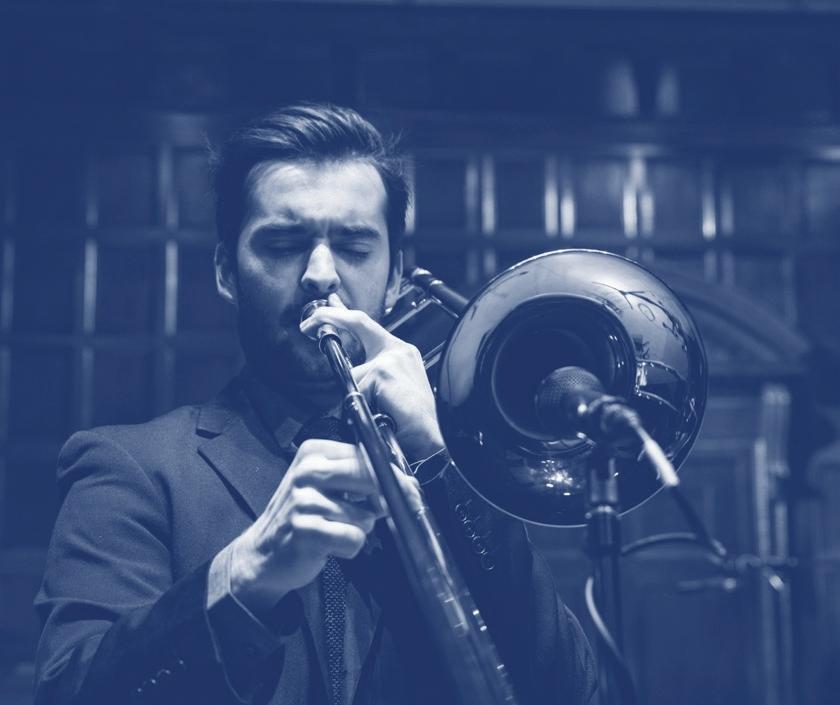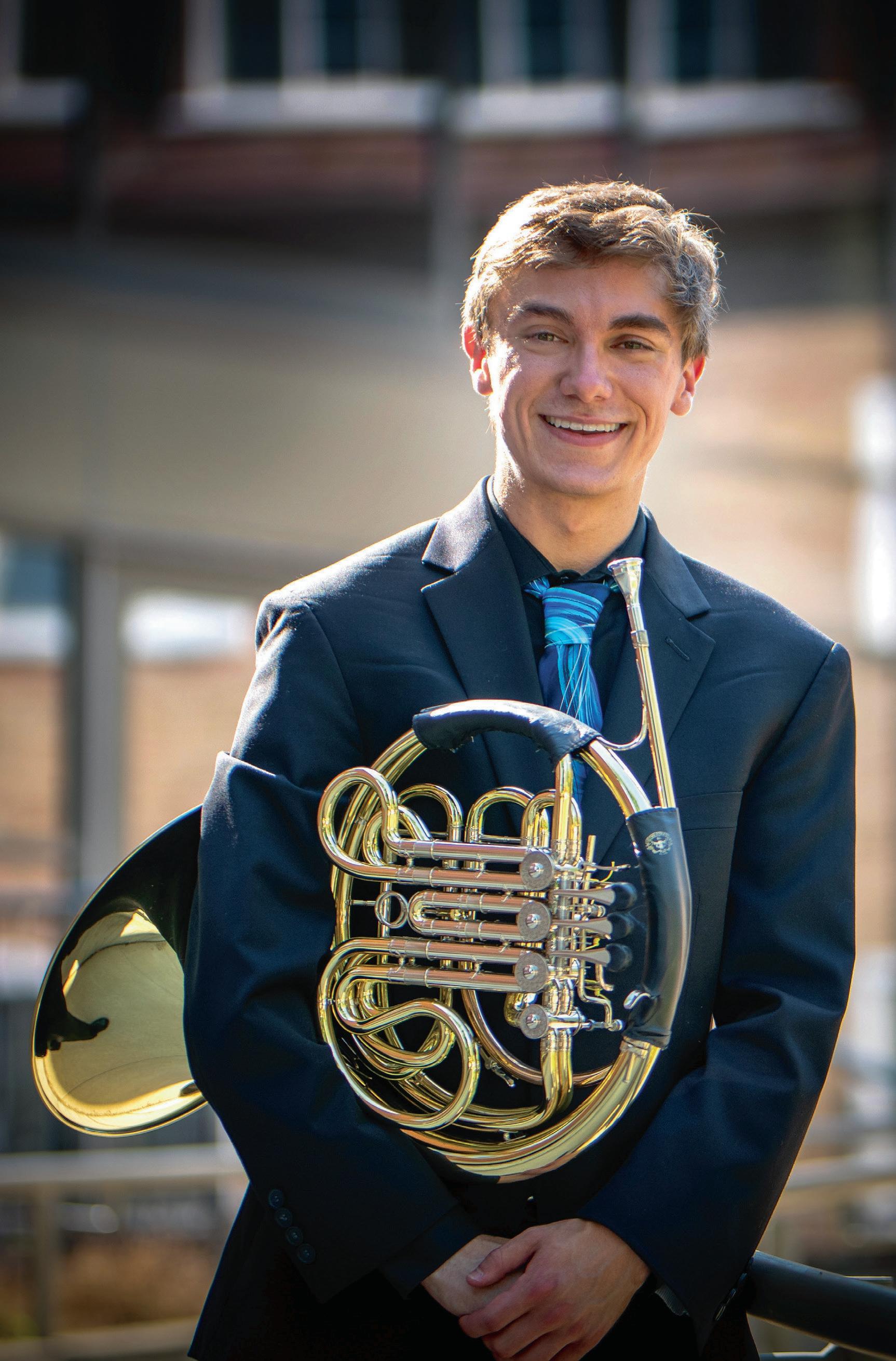

Concert May 3, 2024














Concert May 3, 2024











Jack, Joseph and Morton Mandel Concert Hall at Severance Music Center Friday, May 3, 2024, at 8 PM
Daniel Reith, conductor
VALERIE COLEMAN (b. 1970)
ÉDOUARD LALO (1823–1892)
PYOTR ILYICH TCHAIKOVSKY (1840–1893)
Umoja: Anthem of Unity
Cello Concerto in D minor
I. Prélude: Lento — Allegro maestoso
II. Intermezzo: Andantino con moto — Allegro presto
III. Introduction: Andante — Allegro vivace
Elena Ziegler, cello
Symphony No. 4 in F minor, Op. 36
I. Andante sostenuto — Moderato con anima
II. Andantino in modo di canzona
III. Scherzo: Pizzicato ostinato
IV. Finale: Allegro con fuoco
This program is about 1 hour, 40 minutes in length.
The Cleveland Orchestra Youth Orchestra’s 2023–24 season is dedicated to the memory of Sarah Gray Gund, 1942–2023.
Major support for The Cleveland Orchestra Youth Orchestra is provided by The Geoffrey and Sarah Gund Endowment.
This evening’s concert will be broadcast on Ideastream/ WCLV Classical 90.3 FM on Sunday, June 16, at 4 PM.
Composed: women’s chorus, 1997; woodwind quintet, 1999; orchestra, 2019
Duration: about 10 minutes
 BY Valerie Coleman
BY Valerie Coleman
BORN
September 3, 1970, in Louisville, Kentucky
In its original form, Umoja , the Swahili word for “unity” and the first principle of the African Diaspora holiday Kwanzaa, was composed as a simple song for women’s choir. It embodied a sense of “tribal unity” through the feel of a drum circle, the sharing of history through traditional “call-and-response” form and the repetition of a memorable sing-song melody. It was rearranged as a woodwind quintet during the genesis of Coleman’s chamber music ensemble, Imani Winds, with the intent of providing an anthem that celebrated the diverse heritages of the ensemble itself.
Almost two decades later from the original, the orchestral version brings an expansion and sophistication to the short and sweet melody, beginning with sustained ethereal passages that float and shift from a bowed vibraphone, supporting the introduction of the melody by solo violin. Here the melody is sweetly singing in its simplest form with an earnest reminiscence of Appalachian style music. From there, the melody dances and weaves throughout the instrument families, interrupted by dissonant viewpoints led by the brass and percussion sections, which represent the clash of injustices, racism, and hate that threaten to gain a foothold in the world today. Spiky textures turn into an aggressive exchange between upper woodwinds and percussion before a return to the melody as a gentle reminder of kindness and humanity. Through the brass-led ensemble tutti, the journey ends with a bold call of unity that harkens back to the original anthem.
The score includes the following inscription:
Listen my people, Children of ALL It’s time for Unity
Hear the Winds call.
Oh a-hum, a-hum Nkosi ah.
Oh a-hum, a-hum Nkosi ah.
Umoja has seen the creation of many versions that are like siblings to one another, similar in many ways, but each with a unique voice that is informed by Coleman’s ever evolving creativity and perspective. Regarding the orchestral version, Coleman states, “This version honors the simple melody that ever was, but is now a full exploration into the meaning of freedom and unity. Now more than ever, Umoja has to ring as a strong and beautiful anthem for the world we live in today.”
—Courtesy of Valerie Coleman
Once upon a time
There was a girl sitting on her bedroom floor
Sheet music in front of her
And earbuds in her ears
She was uninformed, unprepared
All she knew were the notes on the page and the music in her ear
She considered not the composer
The composition, context
She merely listened and watched the scenes unfold
And this is what she saw:
Hesitant, soft, the world is hung in suspense
Breathlessly awaiting the first blush of dawn
The sun timidly peeps her face over the hill
And you can see every frosted spiderweb
A violin ushers in the full bloom of sunrise
The sun reaches out warm tendrils of light
Melts the frost bit by bit
And the drowsy town begins to wake
A boy kicks petulantly, and the milk can spills
Instant regret.
His mother’s voice rises sharply through the morning breeze
A slipper slaps, the boy yelps, and chaos ensues
As baby cries and dog barks, the boy slips out inconspicuously
Free from the shackles of chores, he runs off to play with his friends
Mischief is so much more enjoyable with cohorts
And then the clear storyline fades
And an eddy of experiences swirl before the girl’s eyes
Dancing in the rain
And running down green hills in a dress with a bonnet in hand and hair flying
Strolling down a dusty farm road with geese following close behind
And knitting with a grandmother on a porch step
Watching the ships come into the harbor from abroad
And embarking on a ship
Leaving your small town
With the salt mist on your face
The wind in your hair
The horizon stretching ahead of you
And the sailors swinging from the sails
Then the music ended
And the girl gently came back down to earth.
Cyprus Foster is a violinist in her second year in The Cleveland Orchestra Youth Orchestra. Besides music, her interests include soccer, composition, and creative writing. This poem was based on Foster’s impressions of listening to Valerie Coleman’s Umoja for the first time.
Composed: 1877
Duration: about 25 minutes
 BY Édouard Lalo
BY Édouard Lalo
BORN
January 27, 1823, in Lille, France
DIED
April 22, 1892, in Paris
Édouard Lalo has long retained a favored place in the symphonic repertory with his tuneful Symphonie espagnole, which is more like a five-movement violin concerto (and not really what we think of today as a symphony). Equally popular is his Cello Concerto, which students everywhere keep on their music stands.
Frustrated in the field of opera, where his successes were few — with the exception of Le Roi d’Ys (The King of Ys) — Lalo turned his attention in the 1870s to composing symphonic works. He was encouraged in this by the formation of new orchestras and the Société Nationale de Musique, whose purpose was to demonstrate that France, defeated in arms after the Franco-Prussian War, could offer a real challenge to Germany in cultural riches and refinement.
Lalo began with a Violin Concerto, composed for the great Spanish virtuoso Pablo de Sarasate, in 1874. The Symphonie espagnole, also for Sarasate and an immediate hit, followed the next year. The Cello Concerto falls in the middle of this productive period for Lalo, composed in 1877 and soon heard across Europe (and beyond).
Cello concertos of top quality have always been scarce (none by Mozart, Beethoven, Schubert, or Mendelssohn), yet Lalo’s is certainly the equal of Haydn’s and Robert Schumann’s. Superbly written for the instrument, it is a melodious and well-balanced work that shows his fine craftsmanship in the best light.
Each movement starts slowly. In the first movement, a firm declaration of the orchestra’s main theme, punctuated by Lalo’s signature fortissimo (very loud) thumps, prefaces the soloist’s entry. Some expressive refrains lead into the stirring main section, led forcefully by the soloist, who is given little respite in the whole of this energetic movement. The second subject, in the cello’s most expressive tenor range, is a gorgeous melody heard against some delicate flute entries and rich harmony. There are some extraordinarily compelling pages to close the movement, as the torrent of notes from the cello seems to drive onward and upward to the final recall of the opening theme in the full orchestra.
The middle movement functions as the expected concerto slow movement, but Lalo ingeniously works it to also function as a dance-like scherzo movement by sliding into
a swift 6/8 tempo. Against a constant pattern of plucked strings and low flutes, the cello has teasing rhythms and repetitive phrases, almost as if improvising rather than following notes on a printed page. A return of the slow music and, in turn, an encore of the swift music provide perfect balance.
The finale third movement draws fully on Lalo’s unstoppable sense of rhythm and his effortless melodic gift. Here, the vigor and energy of Lalo’s music places it in striking contrast with the willowy, watery style that is too often assumed to be an essential characteristic of French music.
— Hugh Macdonald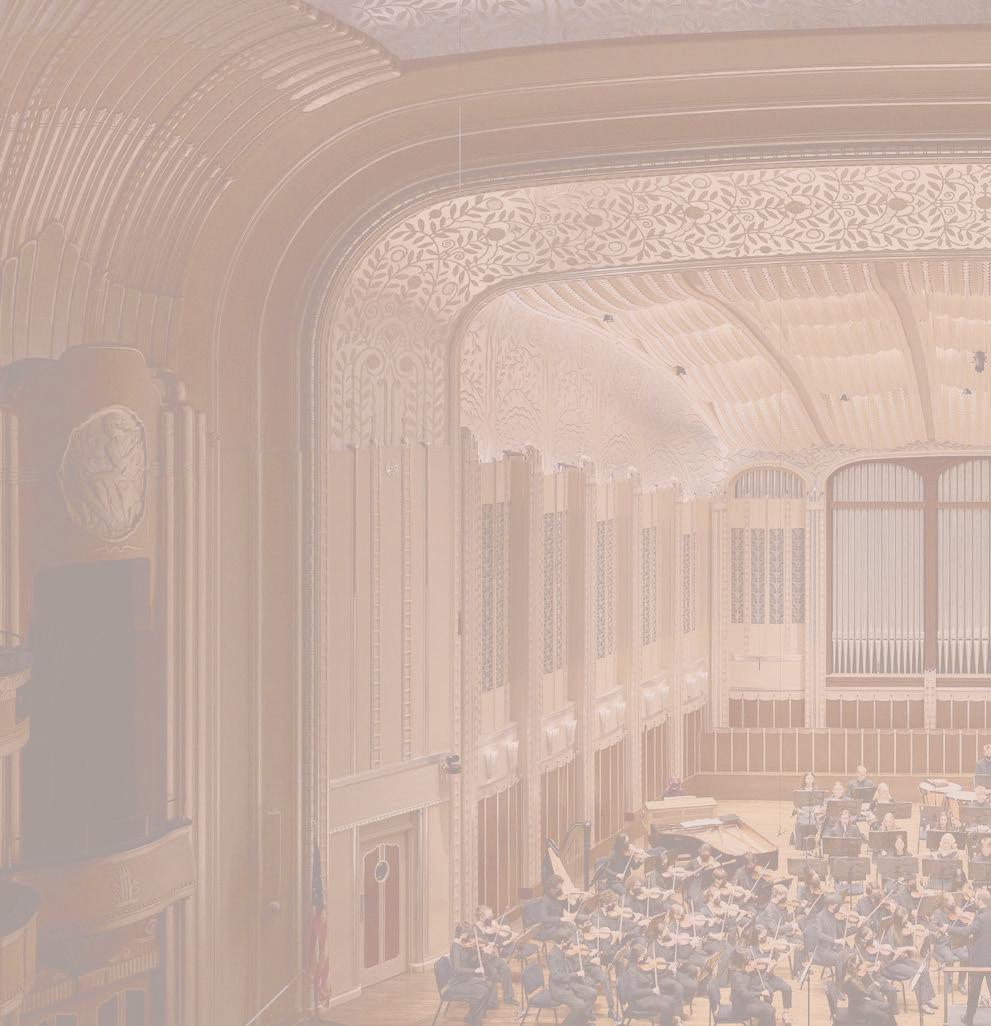



Composed: 1877–78
Duration: about 45 minutes
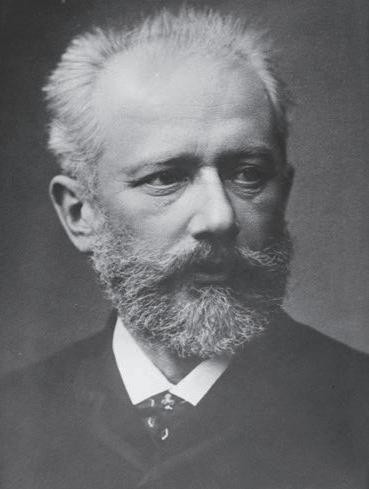 BY Pyotr Ilyich Tchaikovsky
BY Pyotr Ilyich Tchaikovsky
BORN
May 7, 1840, in Votkinsk, Russia
DIED
November 6, 1893, in St. Petersburg
Few works in the orchestral repertoire carry such a strong emotional charge as Tchaikovsky’s Fourth Symphony. The capacity of this music to move us to the depths is by design. Tchaikovsky admitted as much: “There is not a note in this symphony … which I did not feel deeply, and which did not serve as an echo of sincere impulses within my soul.”
To his patroness Nadezhda von Meck, with whom he kept up a close correspondence for over 14 years, only ever meeting twice (both briefly, and by accident), he explained the program of the Fourth Symphony in great detail. According to his first-hand analysis, the gloomier parts of the work are concerned with fate (represented in the opening passage for brass) and depression, and the eternal struggle to rise above it. There are some brighter moments, and the finale supposedly presents a shared joy of community, a cure for the self-hatred and despair that otherwise invades the soul.
It can be argued (and many have) as to whether Tchaikovsky intended for Madame von Meck (or us) to take this program literally. Certainly we should not assume that the symphony is merely a record of the emotional and psychological crisis that he suffered at the time of its composition. The year 1877 brought the composer to a point where suicide was at least a possibility — spurred in part by his failed, two-and-a-half-month marriage that he hoped would cure him of his homosexuality — which doubtless are reflected in the symphony’s music. But the process of creating art is not a simple translation of life into another medium — a transformation occurs in the creative mind. How specifically the music mirrors actual events is not easy to determine. Nor do we need to know in order to enjoy this musical masterpiece.
At the start of the Fourth Symphony, the forthright statement of horns and bassoons grabs the listener’s attention. We are not likely to overlook its recurrence at critical points in this and later movements — and we are not supposed to. But the music settles into a plaintive flow in a halting triple rhythm, overwhelmingly committed to the minor key. The first movement offers some striking contrasts of mood and key, but the main theme returns, and the symphonic argument leads to the first of many stupendous climaxes in this work.
The second movement is not a profound moment of soul-searching, but a tender intermezzo featuring the solo oboe (and later, other winds), very lightly accompanied. There is a strong Russian flavor in this movement and no smiles.
The mood lightens in the third movement, one of Tchaikovsky’s best inventions. The conventional division of the orchestra into three families of strings, woodwinds, and brass gave him the idea of featuring each in turn, each with its own melody, its own tempo, and its own character. The strings, furthermore, are plucked throughout, the entire movement calling for pizzicato. The divisions are not watertight — the themes keep intruding — but the impression is of a teasing game, full of humor and free from dark thoughts of any kind.
The noisy finale features in its midst a Russian folk song based on a descending minor scale answered (sometimes) by two solid “thumps.” In due course, the solemn main theme makes its dramatic reappearance, but it cannot stem the tide of high spirits that close the symphony, leaving Tchaikovsky’s depression far behind.
— Hugh MacdonaldTHE CLEVELAND ORCHESTRA CELEBRATES
Join us for a festival of concerts, conversations & ideas, inspired by Mozart’s The Magic Flute.






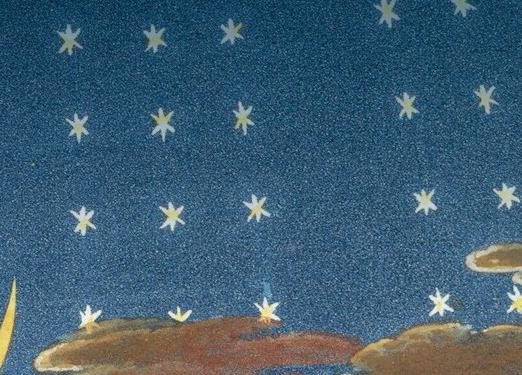




“The second movement of the symphony expresses another aspect of sadness. This is that melancholy feeling which comes in the evening when, weary from one’s toil, one sits alone with a book — but it falls from the hand.”
— Tchaikovsky on the second movement of his Fourth Symphony
In the Fourth Symphony, Tchaikovsky opens his second movement with one of the most famous oboe solos in the world. Perhaps one of the most interesting experiences for any oboist is going from playing the excerpt for an audition to playing it with the full orchestra. Many auditions, including the one for The Cleveland Orchestra Youth Orchestra, list the solo as a required entry or seating audition excerpt. I believe that the biggest difference between audition and performance is the musician’s confidence.
For many, including myself, it’s normal to have nerves before performing in front of judges, since the excerpt is completely exposed. The full score only consists of a light pizzicato from the strings, leaving room for the oboist to express themselves. The solo is placed in an ideal range to play the soft melody that will be echoed by the other sections throughout the movement. Much of that original anxiety gradually fades each rehearsal as the musician prepares themself, building composure and trust in their abilities.
Though my colleague Andrew will play the solo in this evening’s performance, after preparing it for my Youth Orchestra audition and playing it with the orchestra at the occasional rehearsal, I can personally say that after much hard work behind the scenes, a sense of satisfaction and pride comes from showcasing one’s talents through Tchaikovsky’s oboe solo and his entire symphony.
— Eliana Fittante
Eliana Fittante is a freshman oboist who is in her first year of playing in The Cleveland Orchestra Youth Orchestra. She also participates in cross country, show choir, and writes both creative prose and poetry.
Because we are a youth orchestra, for many of us, this is our first time learning most of the pieces we get to play. The opportunity to rehearse and perform great music that we have heard many times in recordings and concerts is an incredible experience. This year, I especially enjoyed playing Shostakovich’s Fifth Symphony in our winter concert. Shostakovich is one of the first composers whose music I really fell in love with. I loved that he could make cheerful, innocent melodies sound so bitterly sarcastic, and how this made his music feel intensely intimate and painful. After listening to my favorite recordings of Shostakovich symphonies so many times, I was thrilled to have the chance to play the Fifth Symphony with The Cleveland Orchestra Youth Orchestra.
Learning an orchestral work for the first time also presents a number of challenges. A piece sounds very different in a recording than it does while playing it yourself in a large group. In recordings, or even in attending live performances as an audience member, it’s a lot easier to hear individual parts and how they fit together. When playing in an orchestra, though, it can be challenging to listen to other sections across the stage while still paying attention to your own section’s sound, and to simultaneously hear how all the parts form one musically cohesive piece. Rehearsing pieces that I have previously only heard in recordings provides an opportunity to appreciate them from a different and unique perspective, which I find to be one of the most enjoyable and rewarding parts of playing in an orchestra.
— Abigail LoefflerAbigail Loeffler is a junior in high school as a homeschool student. She has played violin for four years and is currently in her first year with The Cleveland Orchestra Youth Orchestra.

Cleveland Orchestra Youth Orchestra (COYO) violinist Cyprus Foster created this piece of word art after asking her friends and colleagues in the Youth Orchestra the following question: how would you describe COYO in one word?


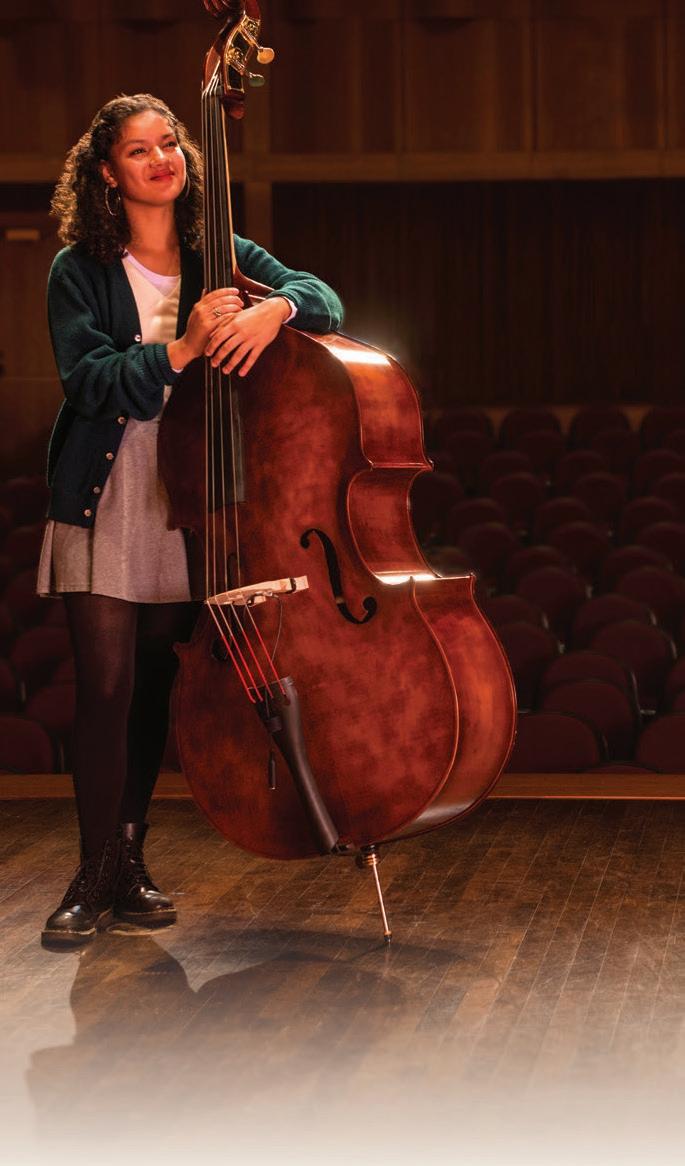

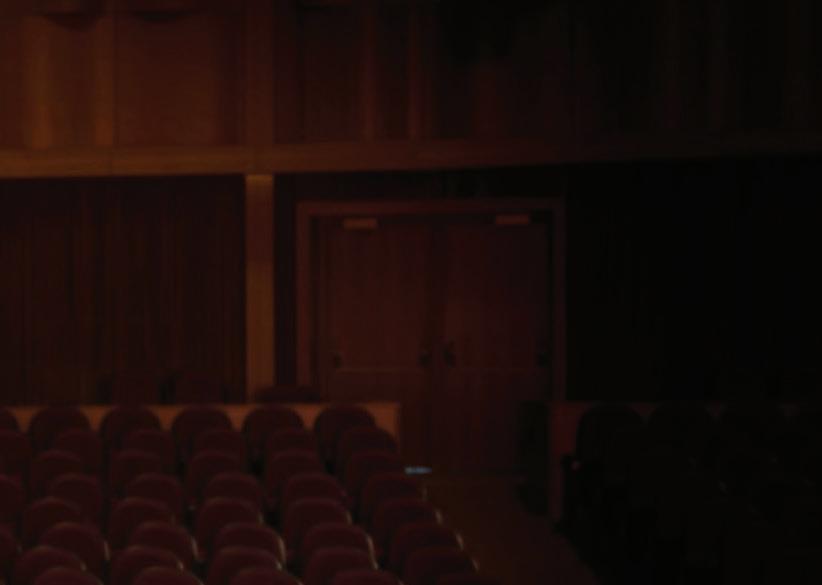



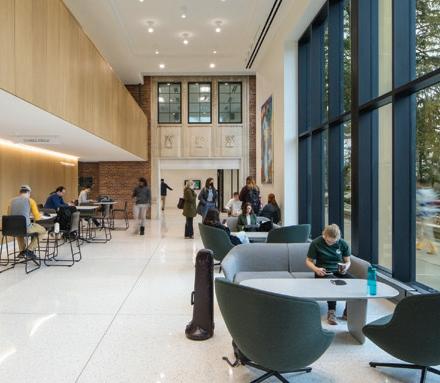


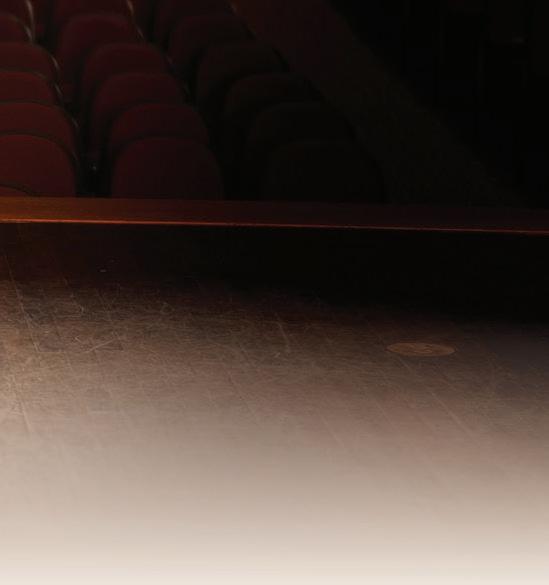

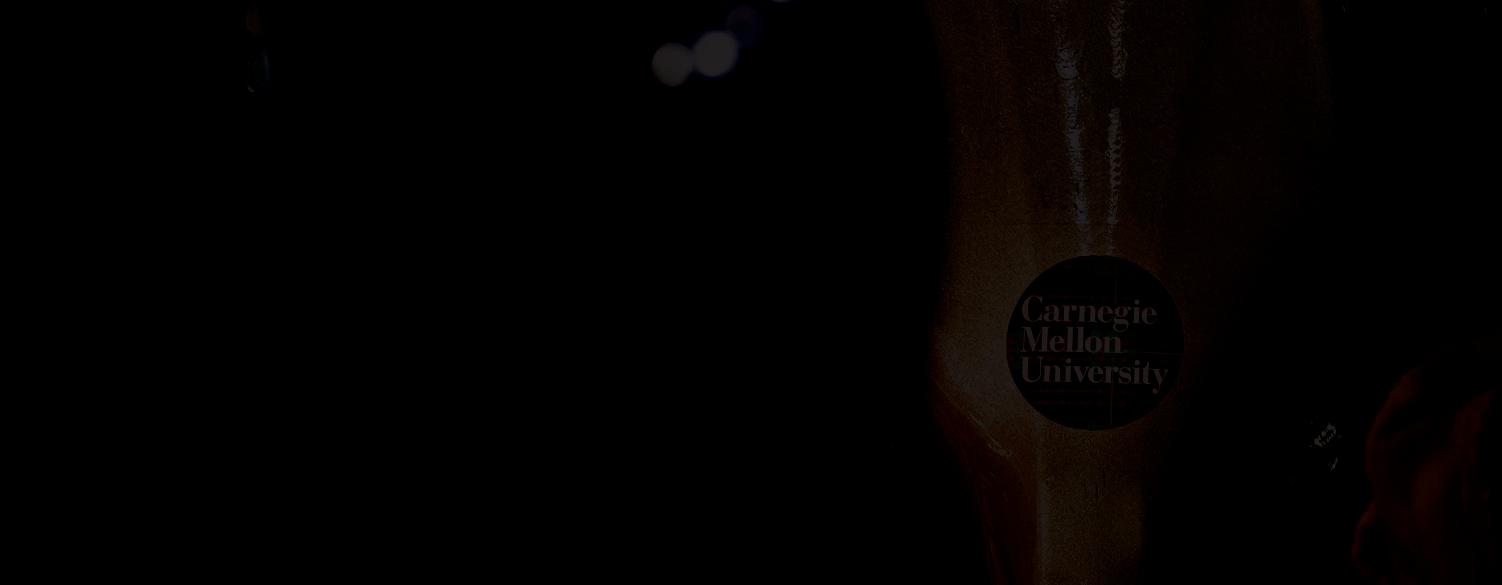



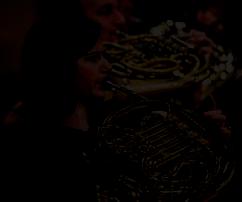
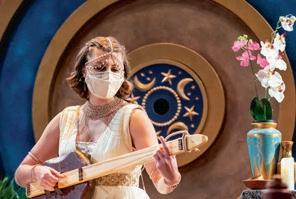


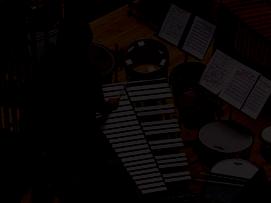







Sherry Du
CONCERTMASTER
Hudson High School
Cyprus Foster
ASSISTANT CONCERTMASTER Homeschooled
Avaneesh Polaconda
Strongsville High School
Hana Mazak
Brecksville-Broadview Heights High School
Harris Wang
Solon High School
Grace Watters
Bio-Med Science Academy
Chengyu Jiang
Solon High School
Andrew Heinzen
Cleveland Heights High School
Elizabeth Liu
Beachwood High School
Anika Westerbeke
Hawken Mastery School
Alice Han
Beachwood High School
Kailani Farivar
Solon High School
Alex Jin
Aurora High School
Hannah Lee
Hudson High School
Nikita Shu-Li Thakore
Hathaway Brown
Cailyn Hua
Western Reserve Academy
Sophie Ng
PRINCIPAL
Avon High School
Carol Huang
ASSISTANT PRINCIPAL
Hathaway Brown
Philip Yao
Aurora High School
Aika Birch
Jackson High School
Peter Dzero
Hudson Montessori School
Kevin Zhao
Solon High School
Cavin Xue
Western Reserve Academy
Mason Zhang
Shaker Heights High School
Abigail Loeffler
Homeschooled
Aaron Wei
Solon High School
James Gordon
Cleveland School of the Arts
Nathaniel Tisch
Cleveland Heights High School
Brayden Qi
Hawken Upper School
Kaden Runge
Hawken Upper School
VIOLAS
Julia Peyrebrune T The Lyceum
Milo Page C, L Homeschooled
Lindsey Jones
ASSISTANT PRINCIPAL Oberlin High School
Connor Smith
North Olmsted High School
Raahil Shammin
Lake Ridge Academy
Yi-Kun Zhao University School
Jason Wei
Solon High School
Elizabeth Pineda
Hawken Upper School
Ada Ortan C, L
Avon High School
Stine Adkins T
Westlake High School
Chengyu Li
ASSISTANT PRINCIPAL
Beachwood High School
Louis X. Wang
Solon High School
Evan Tanko
Wadsworth High School
Aiden Tian
Hawken Upper School
Nicholas Jacques
Menlo Park Academy
Kaiden Honaker Twinsburg High School
Calem Nagy
Avon High School
Claire Hua Western Reserve Academy
Elena Ziegler
Copley High School
Michael Zhu University School
Rowan Toth-Cseplo
PRINCIPAL Firestone CLC
Travis Phillips
ASSISTANT PRINCIPAL University School
Sullivan Wiggins
Shaker Heights High School
Jaren Jenyk
Twinsburg High School
Luca Brusco
Brunswick High School
Bobby Johnston
Brecksville-Broadview Heights High School
Kate Davis
Firestone CLC
Cole Flores C
Strongsville High School
Christine Kim
Hathaway Brown
Elena Ko T
Avon High School
Jonah Miller L
Homeschooled
PICCOLO
Cole Flores T
Christine Kim
Elena Ko C
OBOES
Eliana Fittante L
Ontario High School
Jamil Halabi C
Strongsville High School
Andrew Kelly T Bay High School
Isabel Martin
Walsh Jesuit High School
ENGLISH HORN
Isabel Martin C
CLARINETS
Nicholas Vance Garrett C
Cleveland School of the Arts
Ava Haehn L
Riverside High School
Luke Kuang
University School
Abby Maher T
Strongsville High School
BASS CLARINET
Abby Maher C
William Huber C Firestone CLC
Meghan Janke L
Green High School
Bernadette Slattery T Westlake High School
HORNS
Jack Berendt C, L, T
Aurora High School
Olivia Simpson
Strongsville High School
Samuel Zozulya
Strongsville High School
Layan Atieh**
Frank Berendt
Aurora High School
Joey Dunn C, T
Coventry High School
Sam Haskell L
Brunswick High School
Owen Rinaldo
Stow-Munroe Falls High School
TROMBONES
Grace Berendt C, L
Aurora High School
Elden Schrembeck T
Lake High School
Thomas Toth
Mentor High School
TUBA
Casey Mobley C, T
Wadsworth High School
The following eight endowed Youth Orchestra chairs have been created in recognition of generous gifts to The Cleveland Orchestra’s endowment: Concertmaster, Daniel Majeske Memorial Chair Principal Cello, Barbara P. and Alan S. Geismer Chair
Principal Viola, Anthony T. and Patricia A. Lauria Chair
TIMPANI
Nathaniel Pino T
Solon High School
David Schrembeck C, L
Lake High School
PERCUSSION
Abby Bemak
Lakeland Community College
Nathaniel Pino
Justin Reimschisel
Solon High School
HARP
Lina Tian C Hathaway Brown
KEYBOARD
Saya Uejima C Green High School
MANAGER
Kennedy McKain
LIBRARIAN
Nick Taylor
DIRECTOR OF INSTRUMENTAL PATHWAYS
Lauren Generette
Performers are listed alphabetically within each woodwind, brass, and percussion section. Superscripts indicate principal player according to the following key:
C Coleman
L Lalo
T Tchaikovsky
** Extra/substitute musician
Principal Bass, Anthony F. Knight Memorial Chair Principal Flute, Virginia S. Jones Memorial Chair Piccolo, Patience Cameron Hoskins Chair
Principal Harp, Norma Battes Chair
Principal Keyboard, Victor C. Laughlin M.D. Memorial Chair
Music Director, The Cleveland Orchestra Youth Orchestra Assistant Conductor, The Cleveland Orchestra, Sidney and Doris Dworkin Chair
Daniel Reith was appointed assistant conductor of The Cleveland Orchestra and music director of The Cleveland Orchestra Youth Orchestra (COYO) starting in the 2022–23 season. As COYO’s music director, Reith oversees the ensemble’s artistic planning, selects personnel for the ensemble, and leads rehearsals and performances of the Youth Orchestra. He’s also actively involved with the Orchestra’s education programs and community performances, and provides assistance for the Orchestra’s Classical and Blossom Music Festival seasons.
Reith was the 2019 winner of Opptakt, Talent Norway’s program for fostering young conductors, and has since performed with the Bergen Philharmonic Orchestra, Norwegian Radio Orchestra, Stavanger Symphony Orchestra, Trondheim Symphony Orchestra, and the Norwegian Armed Forces. In 2022, Reith made his debuts with the Kristiansand Symphony Orchestra and Oslo Philharmonic Orchestra. He also served as assistant conductor for the Norwegian Opera production of Orpheus in the Underworld
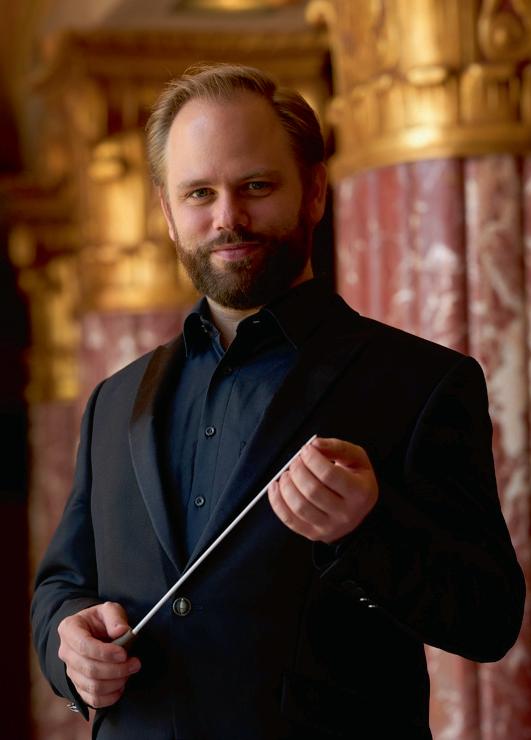
In addition to his conducting work, Reith is a talented pianist and chamber musician, having performed in concerts and competitions throughout Germany, Norway, and other countries. Reith has been awarded several scholarships in Germany, where he’s worked with orchestras such as the Hamburg Philharmonic and Neubrandenburg Philharmonic.
Reith grew up in Bühl, Germany, and studied music in his home country as well as Norway. He received bachelor’s degrees in piano from Freiburg’s Academy of Music and the Norwegian Academy of Music. He also received a bachelor’s degree in music theory at Freiburg’s Academy of Music, followed by a bachelor’s degree in conducting at Frankfurt University of Music and Performing Arts. In 2021, he received his master’s degree in conducting at the Norwegian Academy of Music.
Cello
Elena Ziegler has been a member of The Cleveland Orchestra Youth Orchestra since 2021. She started cello studies at age 5 with Andris Koh, and later studied with Pamela Kelly and Martha Baldwin at the Cleveland Institute of Music (CIM). She currently studies with Dmitry Kouzov from Oberlin Conservatory. Additionally, she has received coaching in orchestral music with Charles Bernard and sonata repertoire with Carolyn Gadiel Warner (both members of The Cleveland Orchestra).
Ziegler has participated in several summer music programs, including the Bowdoin International Chamber Music Festival, Orford Music, Ascent Cello Festival, and the Credo Chamber Music Festival. She has also been recognized in music competitions, placing first in the Sigma Alpha Iota String Competition in 2019, winning the elementary (2015) and junior divisions (2021) for the Cleveland Cello Society Scholarship Competition, and receiving prizes in the Ohio Federation of Music Club’s Charlotte & W. Alfred Grey Competition (2022 and 2023).

Ziegler is also actively involved in local music activities and charities. She has been invited several times to perform at the Tuesday Musical Association’s membership program as a representative of the Brahms Allegro Junior Music Club. In 2016, Ziegler participated in the fundraising concert Bach for Locks alongside her violinist sister, Marina, to raise money for the local cancer center, Stewart’s Caring Place. She also performs regularly for local nursing and retirement homes.
In 2017 and 2018, Ziegler sang in the Mussettes Ensemble for the Apollo’s Fire production Christmas on Sugarloaf Mountain and performed at New York’s Metropolitan Museum of Art in December 2018. In her spare time, Ziegler enjoys teaching cello and drawing. She attends Copley High School, where she is in the 11th grade.
Stine Adkins (cello, 2022–24) will attend Oberlin College and Conservatory to double major in cello performance and mathematics
Abby Bemak (percussion, 2022–24)
Sherry Du (violin, 2020–24) will attend the University of Pennsylvania to major in chemical and biomolecular engineering with a minor in violin performance
Joey Dunn (trumpet, 2023–24) will attend The University of Akron to major in music education and performance
James Gordon (violin, 2023–24) will attend either Baldwin Wallace University or Butler University to major in violin performance
Ava Haehn (clarinet, 2020–24)
Jamil Halabi (oboe, 2023–24) will attend Baldwin Wallace University to major in oboe performance and music education
William Huber (bassoon, 2023–24)
Christine Kim (flute, 2022–24)
Elena Ko (flute, 2022–24) will attend Brown University to double major in English and literary arts
Luke Kuang (clarinet, 2023–24) will attend the University of Virginia
Abby Maher (clarinet, 2023–24) will attend the University of Cincinnati College-Conservatory of Music to double major in clarinet performance and music education
Hana Mazak (violin, 2020–24)
Jonah Miller (flute, 2023–24)
Casey Mobley (tuba, 2022–24) will attend the University of Tennessee to major in music performance
Calem Nagy (cello, 2023–24)
Sophie Ng (violin, 2020–24) will attend the University of Michigan to major in violin performance
Ada Ortan (cello, 2020–24)
Milo Page (viola, 2020–24) will attend Oberlin College and Conservatory to major in viola performance
Julia Peyrebrune (viola, 2021–24) will attend Hillsdale College
Kaden Runge (violin, 2023–24) will attend either The Ohio State University or Northeastern University
David Schrembeck (percussion, 2022–24) will attend The University of Akron to double major in music education and percussion performance
Elden Schrembeck (trombone, 2022–24) will attend The University of Akron to major in trombone performance and jazz studies
Raahil Shammin (viola, 2023–24) will attend Swarthmore College to major in mathematics
Evan Tanko (cello, 2023–24) will attend The University of Akron to double major in aerospace engineering and cello performance
Nikita Shu-Li Thakore (violin, 2023–24) will attend Boston University to major in economics and biology
Nathaniel Tisch (violin, 2023–24) plans to major in history
Thomas Toth (trombone, 2022–24) will attend the University of Cincinnati CollegeConservatory of Music to major in trombone performance
Rowan Toth-Cseplo (bass, 2021–24) will attend the Eastman School of Music to major in bass performance
Cavin Xue (violin, 2021–24) will attend Brown University to major in biomedical engineering
Philip Yao (violin, 2023–24)
Samuel Zozulya (horn, 2023–24) will attend Baldwin Wallace University to major in horn performance
The thousands of students who have been members of The Cleveland Orchestra Youth Orchestra represent a remarkable group of talented young people. For some, their interest in music has carried them forward into careers as educators and performers. For others, music continues as an important part of their lives and careers in business, the arts, recreation, or community service. We offer our sincere congratulations to this year’s class and wish them success on the next leg of their journey!

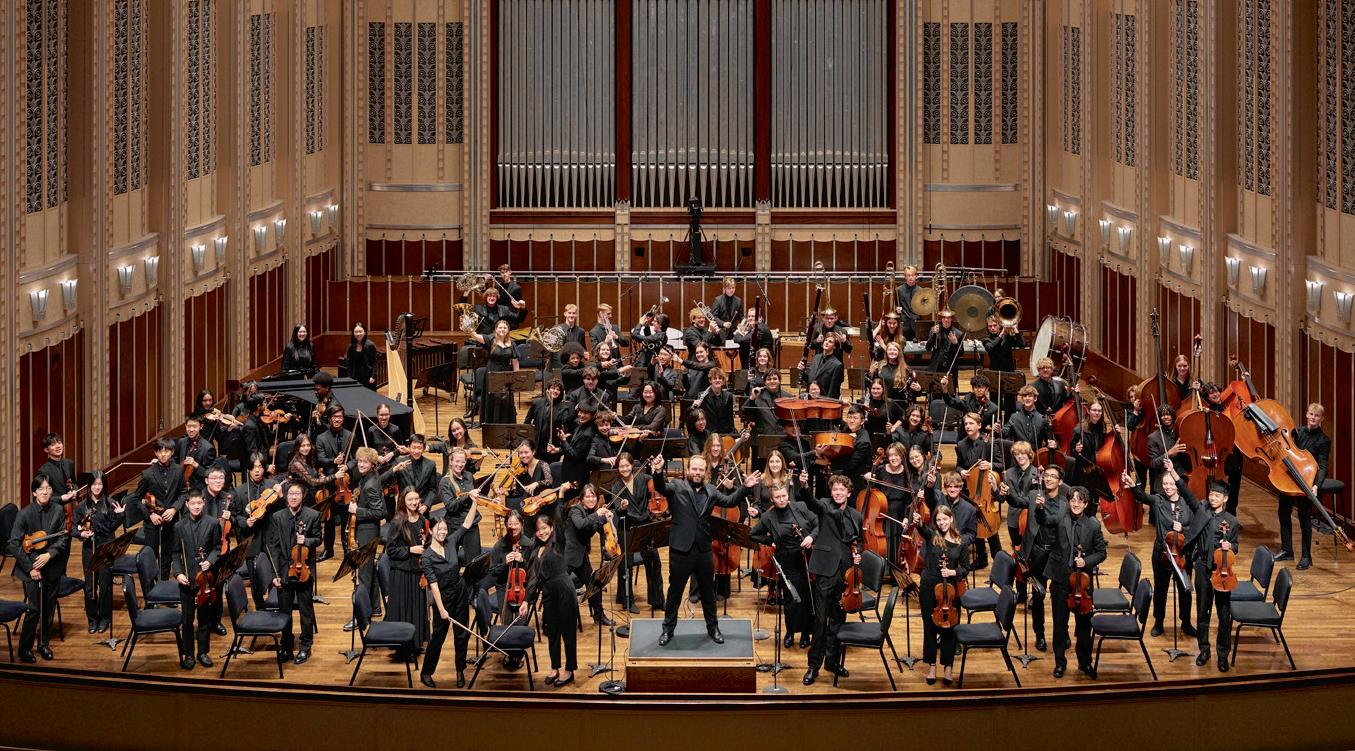
The Cleveland Orchestra Youth Orchestra is a full symphonic ensemble composed of 90 young musicians drawn from 41 communities in 11 counties across Northern Ohio. Founded in 1986 by Jahja Ling (then resident conductor of The Cleveland Orchestra), The Cleveland Orchestra Youth Orchestra (COYO) provides serious young music students of middle and high school age with a unique pre-professional orchestral training experience. The 2023–24 season marks COYO’s 38th season and the second under the direction of Daniel Reith.
Among the acclaimed artists to work with COYO are Marin Alsop, Pierre Boulez, Stéphane Denève, Christoph von Dohnányi, Giancarlo Guerrero, Witold Lutosławski, Yo-Yo Ma, Gil Shaham, Michael Tilson Thomas, Antoni Wit, and Cleveland Orchestra Music Director Franz Welser-Möst. The ensemble has been featured on three international tours.
The Cleveland Orchestra Youth Orchestra is part of a suite of Cleveland Orchestra programs designed to nurture aspiring young musicians, which also includes The Cleveland Orchestra Youth Chorus, The Cleveland Orchestra Children’s Chorus and Preparatory Chorus, and the Crescendo and Music Mentors pathways initiatives for students in Cleveland schools. In addition, with the support of many generous individual, foundation, corporate, and governmental funding partners, the Orchestra’s full range of education and community programs reach more than 100,000 young people and adults annually, helping to foster a lifelong relationship with music by removing barriers to participation, advocating for and helping to facilitate equitable access to comprehensive music education in schools, and harnessing the life-changing power in service to the community.
The following members of The Cleveland Orchestra have served as section coaches for the Youth Orchestra in preparation for this concert:
VIOLINS
Stephen Tavani
Assistant Concertmaster
Kathleen Collins
Katherine Bormann
VIOLA
Stanley Konopka Assistant Principal
CELLOS
David Alan Harrell
BASSES
Mark Atherton
FLUTE
Jessica Sindell Assistant Principal
OBOE
Frank Rosenwein Principal
CLARINET
Robert Woolfrey
BASSOON
Phil Austin Emeritus
HORN
Hans Clebsch
TRUMPET
Jack Sutte
TROMBONE
Shachar Israel
Assistant Principal
TUBA
Yasuhito Sugiyama
PERCUSSION
Donald Miller Emeritus
HARP
Trina Struble Principal
KEYBOARD
Joela Jones Emeritus
WITH SPECIAL THANKS
Michael Ferraguto Librarian
The members of The Cleveland Orchestra Youth Orchestra express gratitude to their school music directors for the role they play on a daily basis in developing musical skills:
Jason Burdett
Aurora High School
Mason Smith
Aurora High School
Jesse Martin
Avon High School
Devon Gess
Bay High School
David Luddington
Beachwood High School
Allison Siekmann
Beachwood High School
Steven Cocchiola
Brecksville-Broadview
Heights High School
Scott Hanna
Brecksville-Broadview
Heights High School
Ethan Eraybar
Brunswick High School
Valerie Roman
Brunswick High School
Daniel Heim
Cleveland Heights High School
Robert Davis
Cleveland School of the Arts
Dianna Richardson
Cleveland School of the Arts
Basil Kochan
Copley High School
Brandon Cummings
Coventry High School
Matthew Kennedy
Firestone CLC
Sloan Stakleff
Firestone CLC
Amy Rach
Green High School
James Hogan
Hathaway Brown
Curtis Prichard
Hathaway Brown
Stanislav Golovin
Hawken School
Liesl Hook
Hawken School
Kyra Mihalski
Hawken School
Yu Yuan
Hawken School
Roberto Iriarte
Hudson High School
James Rhodes
Hudson Montessori School
Scott Eversdyke
Jackson High School
Jared Cooey
Lake Local Schools
Molibeth Cardwell
Lake Ridge Academy
Joseph Kucel
The Lyceum
Steve Poremba
Mentor High School
Erik Kalish
North Olmsted High School
Emily Cromwell
Oberlin High School
Elijah Henkel
Ontario High School
Donna Jelen
Shaker Heights High School
Gerald MacDougall
Solon High School
Mark Mauldin
Solon High School
Greg Newman
Stow-Munroe Falls High School
Andrew Hire
Strongsville High School
Brian King
Strongsville High School
Damon Conn
Twinsburg High School
David Kay
University School
Devon Steve
University School
Dana Hire
Wadsworth High School
Nicholas Ratay
Walsh Jesuit High School
Margaret Karam
Western Reserve Academy
Hilary Patriok
Westlake High School
The members of The Cleveland Orchestra Youth Orchestra express gratitude to their private teachers for their support, insight, and expertise:
VIOLIN TEACHERS
Masha Andreini
Andrea Belding-Elson
Wei-Shu Co
Kathleen Collins*
Heather Crawford
Vladimir Deninzon
Francesca dePasquale
Kim Gomez*
Wei-Fang Gu*
Liesl Hook
Callista Koh
Amy Lee*
James MacQueen
Kimberly Meier-Sims
Sonja Braaten Molloy*
Eugenia Poustyreva
James Rhodes
Barton (Sam) Rotberg
Carol Ruzicka
Laura Shuster
Stephen Sims
Jennifer Walvoord
Joy Wiener
Ann Yu
Yu Yuan*
VIOLA TEACHERS
Jeffrey Irvine
Laura Keunen-Poper
Carol Ross
Lembi Veskimets*
Eric Wong
Louise Zeitlin
CELLO TEACHERS
Martha Baldwin*
Kellan Degnan
Marla Gigliotti
Abbey Hansen
David Alan Harrell*
Hannah Hintz
Dimitry Kouzov
Paul Kushious*
Daniel Pereira
Elizabeth Zadinsky
BASS TEACHERS
Patricia Johnston
Tracy Rowell
Bryan Thomas
Gavin VanWinkle-Bright
Susan Yelanjian
FLUTE TEACHERS
Kyra Kester
Alexa Still
Audrey Whartenby
Jackie Wood
OBOE TEACHERS
Carol Bernhardt
Kathleen Fling
Corbin Stair*
Danna Sundet
CLARINET TEACHERS
Stanislav Golovin
Mary Ann Neiman
Tom Tweedle
Robert Woolfrey*
BASSOON TEACHERS
Cynthia Cioffari
Tom English
Judith Guegold
HORN TEACHERS
Alan DeMattia
Melinda Kellerstrass
TRUMPET TEACHERS
Michael Fox
Jerry Kleman
Michael Miller*
Erik Sundet
TROMBONE TEACHERS
Adam Landry
Eric Richmond
Lauren Rudzinskas
TUBA TEACHER
Christopher Blaha
PERCUSSION TEACHERS
Katy La Favre
Jennalee Quillen
Luke Rinderknecht
Joan Wenzel
HARP TEACHER
Jody Guinn
KEYBOARD TEACHER
Mayumi Kikuchi
* Member of The Cleveland Orchestra

As a courtesy to the audience members and musicians in the hall, late-arriving patrons are asked to wait quietly until the first convenient break in the program, when ushers will help you to your seats. These seating breaks are at the discretion of the House Manager in consultation with the performing artists.
Please silence any alarms or ringers on pagers, cell phones, or wristwatches prior to the start of the concert.
VIDEOGRAPHY, AND RECORDING
Audio recording, photography, and videography are prohibited during performances at Severance. Photographs of the hall and selfies can be taken when the performance is not in progress. As a courtesy to others, please turn off any phone/ device that makes noise or emits light.
NEW FREE MOBILE APP
Get instant access to your tickets for Cleveland Orchestra concerts at Blossom Music Center and Severance by using the Ticket Wallet App. More information is at clevelandorchestra.com/ticketwallet
Contact an usher or a member of house staff if you require medical assistance. Emergency exits are clearly marked throughout the building. Ushers and house staff will provide instructions in the event of an emergency.
For the comfort of those around you, please reduce the volume on hearing aids and other devices that may produce a noise that would detract from the program. Infrared Assistive-Listening Devices are available. Please see the House Manager or Head Usher for more details.
Regardless of age, each person must have a ticket and be able to sit quietly in a seat throughout the performance. Classical Season subscription concerts are not recommended for children under the age of 8. However, there are several age-appropriate series designed specifically for children and youth, including Music Explorers (recommended for children 3 to 6 years old) and Family Concerts (for ages 7 and older).
Copyright © 2024 by The Cleveland Orchestra and Musical Arts Association
Kevin McBrien, Publications Manager (kmcbrien@clevelandorchestra.com)
Program books for Cleveland Orchestra concerts are produced by The Cleveland Orchestra and are distributed free to attending audience members. The Cleveland Orchestra is proud to have its home, Severance Music Center, located on the campus of Case Western Reserve University, with whom it has a long history of collaboration and partnership.
